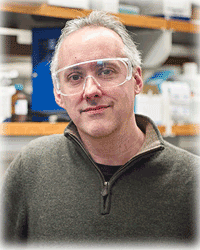
Dennis Wright, PhD
Chief Strategy Officer - Chemistry
Email
Professor of Medicinal Chemistry
University of Connecticut, Storrs
Management of QMD research portfolio
Dr. Wright's research program lies at the interface of organic structure and biological function, and is grounded in a strong synthetic organic core that also includes many important aspects of modern medicinal chemistry, including structure-based drug design, drug disposition/metabolism, and high-throughput screening. He leads a successful research group at the UConn School of Pharmacy, with 18 years continuous research support, including over $10 million in funding, six awarded patents and over 100 peer-reviewed publications, and has trained over 20 doctoral students and several post-doctoral fellows.
His research has benefitted greatly from strong collaborations, allowing him to expand drug design work into new areas. These include:
A long-standing collaboration with Professor Amy Anderson (UConn), an expert in the structural biology and biochemistry of the enzyme dihydrofolate reductase, working closly to integrate the medicinal chemistry and structural biology efforts to develop new inhibitors for use against gram-positive bacterial, gram-negative bacterial, and fungal pathogens.
Collaborating closely with Professor Nigel Priestley (University of Montana), an expert in natural product biosynthesis and microbiology, beginning several initiatives to integrate the power of recombinant biosynthesis and parallel synthesis to develop natural product-like leads for the discovery of new antibiotics.
The collaborative effort with Professor Craig Crews at Yale University, and Dr. Sandra Weller, at the UConn School of Medicine, known as the Program in Innovative Therapeutics for Connecticut Health (PITCH), which is supported by a $10 million grant from the State of Connecticut to more broadly enhance entrepreneurial activity within Connecticut through constructing a unique and unprecedented pipeline to rapidly translate academic discoveries into new private-sector ventures.
A new entrepreneurial collaboration with Dr. Sandra Weller to develop new antiviral agents, combining Dr. Wright's expertise in small-molecule drug discovery with Dr. Weller's deep insight into the biology of herpeseviruses to identify and exploit new drug targets for the treatment of these widespread viral infections.
Academic and Professional Appointments
Chief Strategy Officer - Chemistry, Quercus Molecular Design, 2015-present
Professor, Department of Chemistry, University of Connecticut, 2012-present
Professor, Department of Pharmaceutical Sciences, University of Connecticut, 2012-present
Co-Director, University of Connecticut High-Throughput Screening Facility, 2010-present
Associate Professor, Department of Chemistry, University of Connecticut, 2006-2012
Associate Professor, Department of Pharmaceutical Sciences, University of Connecticut, 2006-2012
Member, Norris Cotton Cancer Center, Dartmouth-Hitchcock Medical Center, 2004-2005
Associate Professor, Department of Chemistry, Dartmouth College, 2003-2006
Assistant Professor, Department of Chemistry, University of Florida, 1998-2003
Postdoctroal Research Fellow, Department of Chemistry, Stanford University, 1996-1998
Graduate Research Fellow, Department of Chemistry, Ohio University, 1991-1996
Other Experience and Professional Memberships
- Undergraduate Fellowship, West Liberty State College 1987-1991
- Outstanding Undergraduate Chemistry Major, West Liberty State College, 1991
- Donald R. Clippinger Graduate Research Award - Ohio University, 1994
- Donald R. Clippinger Graduate Research Award - Ohio University, 1996
- National Science Foundation CAREER Award, 1999
- Provost's Special Achievement Award, University of Connecticut, 2013
- Elected Member of Connecticut Academy of Science and Technology (CASE), 2016
- Member, International Scoiety of Heterocyclic Chemistry, Electrochemical Society
- Reviewer, National Institutes of Health, National Science Foundation, J. American Chemical Society, J. of Organic Chemistry, Tetrahedron Letters, Angewandte Chemie, Organic Letters.
Bibliography Link
Additional Contributions to Science
Development of New Agents for the Treatment of Infectious Disease: Antibacterial and Antifungal Agents
The development of anti-microbial agents is arguably one of the most important areas of academic drug discovery as the need for new agents is unrelenting owing to the onset of resistance. The problem is magnified as many traditional pharmaceutical companies have largely divested from the area due to poor underlying economic assumptions. In a decade-long collaboration with Prof. Amy Anderson, we have utilized a structure-based design approach to developing new inhibitors of the enzyme dihydrofolate reductase, particularly those resistant to the antibiotic trimethoprim. This NIH-funded effort has led to the discovery of the propargyl-linked antifolates, inhibitors characterized by a unique propargylic linker. The linear architecture provides an important balance of rigidity and compactness that allows them to effectively target clinically-resistant mutants of the DHFRs from MRSA and important CREs such as E. coli and K. pneumoniae. We have developed advanced versions of these compounds that are effective in mouse bacteremia models and are currently focusing on more extensive efficacy and safety models to support the translational potential of these compounds. These compounds are now under license to Spero Therapeutics for pre-clinical development.
- Keshipeddy, S, Reeve, S., Anderson, A. and Wright, D. (2015) “Nonracemic Antifolates Stereoselectively Recruit Alternate Cofactors and Overcome Resistance in S. aureus”J. Am. Chem. Soc.137: 8983-8990. PMID: 26098608
- Viswanathan, K.; Frey, K.M.; Scocchera, E.W.; Martin, B.D; Dwain, P.W.; Alverson, J.B.; Priestley, N.D.; Anderson, A.C.; Wright, D.L.* (2012) ”Toward New Therapeutics for Skin and Soft Tissue Infections: Propargyl-Linked Antifolates Are Potent Inhibitors of MRSA and Streptococcus pyogenes. PLoS ONE 7(2): e29434.
- Zhou, W.; Viswanathan, K.; Hill, D.; Anderson, A.C.; Wright, D.L. (2012) “Acetylenic Linkers in Lead Compounds: A Study of the Stability of the Propargyl-Linked Antifolates”Drug Metab. Dispos. 40: 1976-1983.
- G-Dayanandan, N.; Paulsen, J.L.; Viswanathan, K,; Keshipeddy, S.; Lombardo. M.N.; Zhou, W.; Lamb, K.M.; Sochia, A.E.; Alverson, J.B.; Priestley, N.D.; Wright, D.L.*; Anderson, A.C.* (2014) “Propargyl-Linker Antifolates are Dual Inhibitors of Candida Albicans and Candida Glabrata”J. Med. Chem.57, 2643-56.
Studies on Bioactive Natural Products: Methodology, Total Synthesis and Biological Function
I have had a long-standing interest in the potential of natural products as new therapeutic agents, an interest that ranges from the development of new methodology to total synthesis to analog design and evaluation. My group has always been interested in utilizing the unique reactivity of the aromatic heterocycle furan in the construction of architecturally complex terpenoids. We have developed several methods around furans including electrochemical cyclizations, tandem cycloaddition/ring-opening metathesis and tetrabromocyclopropene additions. We have completed total syntheses of frondosin B and platensimycin antibiotics and are now working to improve both their antibacterial activity and pharmacokinetic profile.
- Oblak, E.Z.; VanHeyst, M.D.; Li, J.; Wiemer, A.J.; Wright, D.L.* (2014) “Cyclopropene Cycloadditions with Annulated Furans: Total Synthesis of (+) and (-)-Frondosin B and (+) Frondosin A”J. Am. Chem. Soc.136, 4309-15.
- VanHeyst, M.D.; Oblak, E.Z.; Wright, D.L.* (2013) J. Org. Chem.“Stereodivergent Resolution of Oxabicyclic Ketones: Preparation of Key Intermediates for Platensimycin and Other Natural Products”78:10555-9.
- Oblak, E.Z.; Wright, D.L.(2011) “Highly Substituted Oxabicyclic Derivatives from Furan: Synthesis of (±)-Platensimycin” Org. Lett. 13:2263-5.
Natural Product Inspirations for Drug Discovery
Natural products have long-served as a source of new chemical matter for the discovery of new therapeutic actions. We have been interested in using natural products as inspiration for the design of screening libraries or as lead-like materials for multiple applications. Using recombinant biosynthesis, we were able to produce complex feedstock materials that could be parlayed into diverse compound arrays through parallel synthesis. Using nonactin-based fragments, we discovered several novel compositions with antibiotic activity. More recently, we have been able to exploit the unique lead-like properties of naturally occurring troplones to target key epigenetic pathways (HDACs and Sirt1/2), producing potent leads targeting lymphocytic leukemias.
- Ononye, S.N.; VanHeyst, M.D.; Oblak, E.Z.; Ammar, M.; Anderson, A.C.*; Wright, D.L.* (2013) ACS Med. Chem. Lett.“Tropolones as Lead-Like Natural Products: The Development of Potent Histone Deacetylase Inhibitors” 4: 757-61.
- Oblak, E.Z.; Bolstad, E.; Priestley, N.D.; Hadden, M.K.; Wright, D.L. (2012) “The Furan Route to Tropolones: Probing the Antiproliferative Effects of β-Thujaplicin Analogs”Org. Biomol. Chem. 10:8597-604.
- Ononye, S.N.; VanHeyst, M.D.; Giardina, C.; Wright, D.L.*; Anderson, A.C.* (2014) “Studies on the Antiproliferative Effects of Tropolone Derivatives in Jurkat T-Lymphocyte Cells”Bioorg. Med. Chem.22, 2188-93.
